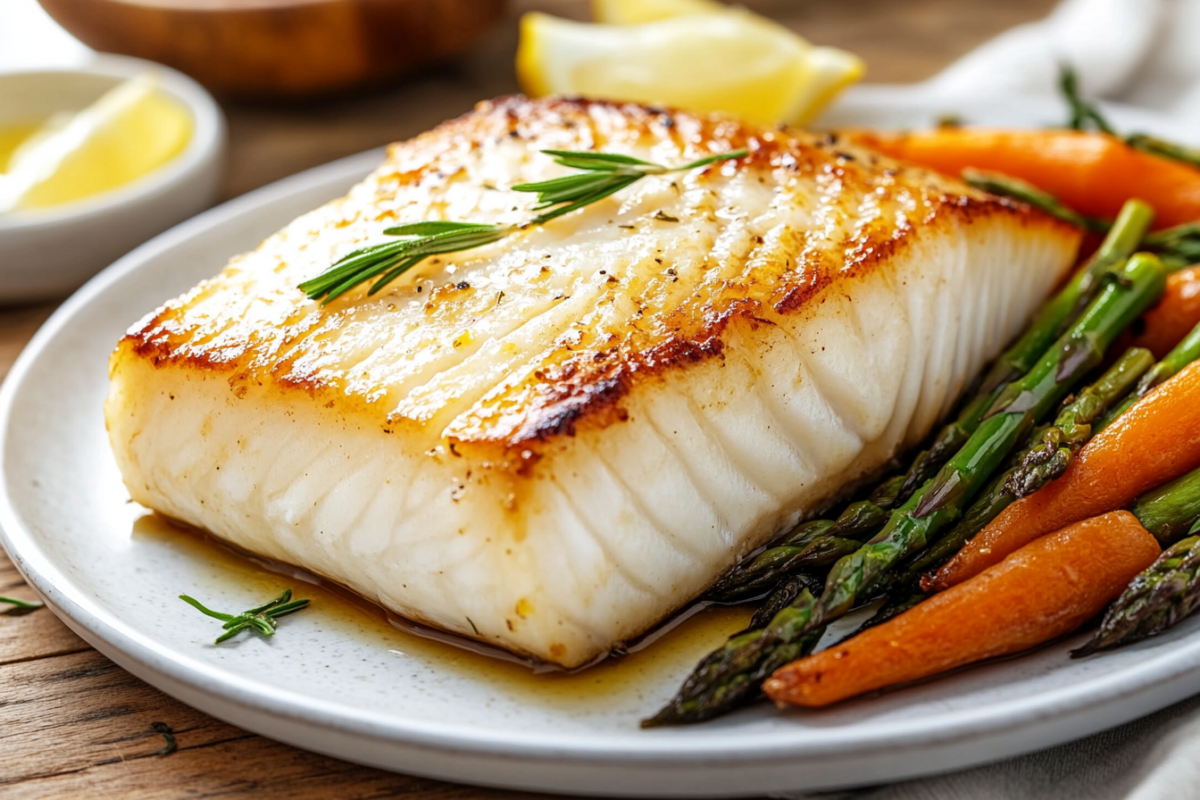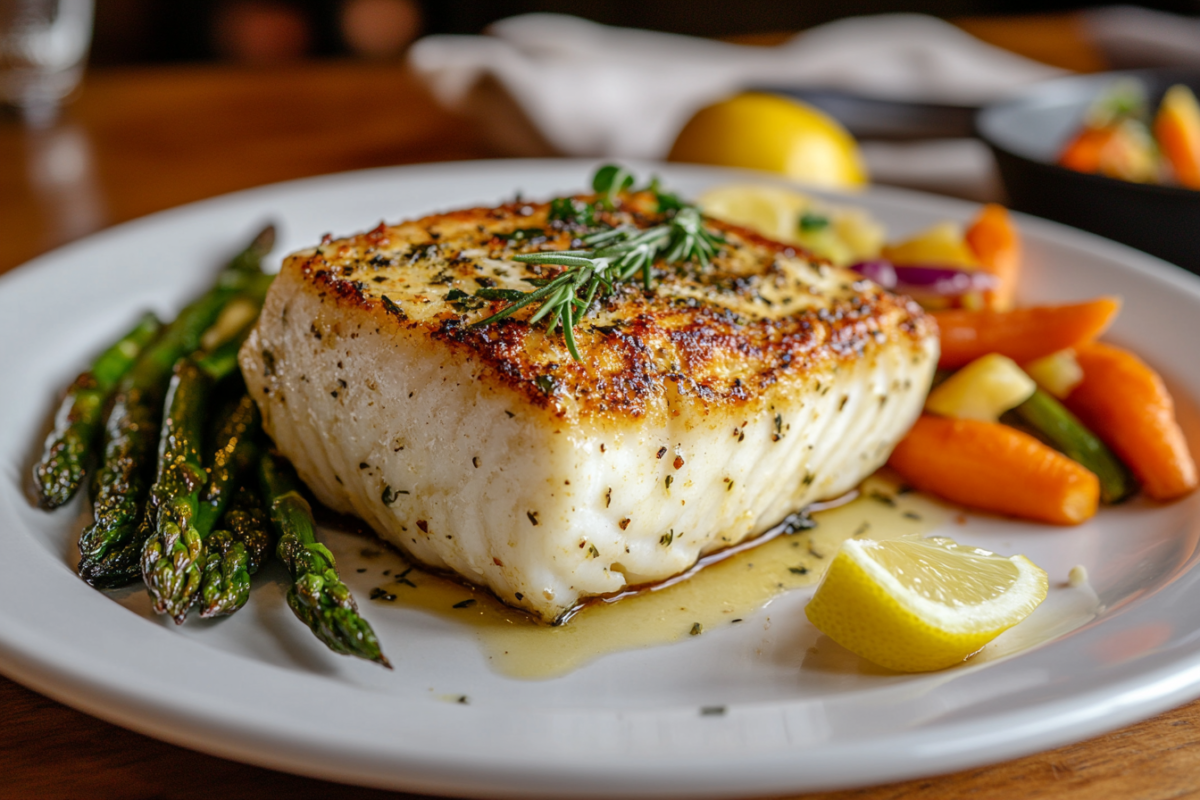If you’re looking for a simple yet delicious baked sablefish recipe, you’re in for a treat. Baked sablefish has gained popularity due to its rich, buttery flavor and tender texture, making it a fantastic choice for dinner. Not only is sablefish easy to prepare, but it’s also packed with nutrients, making it an ideal option for a healthy, satisfying meal. In this article, we’ll guide you through everything you need to know—from understanding sablefish to preparing, baking, and serving the perfect baked sablefish recipe.
Introduction to Baked Sablefish Recipes
What is Sablefish?
Sablefish, often referred to as black cod, is a deep-sea fish found in the North Pacific Ocean. Known for its rich, buttery texture and delicate flavor, it’s a favorite among seafood lovers. But don’t let its gourmet reputation intimidate you—sablefish is surprisingly easy to prepare and bake.
Why Choose Baked Sablefish?
Opting for a baked version of sablefish is not only simple but also a healthy choice. Baking locks in moisture, preserving the fish’s natural flavor while keeping it tender. Plus, you can easily customize baked sablefish recipes with marinades, spices, or herbs to suit your taste.
Understanding Sablefish
What is Sablefish?
Sablefish, also known as black cod, is a deep-sea fish renowned for its rich flavor and tender, flaky texture. This fish thrives in colder waters, particularly along the coasts of the Pacific Ocean. Its white, flaky flesh is higher in fat than many other fish, giving it a buttery taste that makes it a favorite among chefs and home cooks alike. When baked, sablefish retains moisture beautifully, making it a perfect candidate for a variety of flavorful dishes.
Sablefish vs. Black Cod: Are They the Same?
Yes, sablefish and black cod are essentially the same. The term “black cod” is commonly used in North America, especially in the culinary world, while “sablefish” is more commonly used in scientific contexts. While they share the same species, the name “black cod” can be misleading, as they are actually part of the cod family but differ from the typical cod you might find in fish and chips.
Nutritional Benefits of Sablefish
Sablefish is not just a delicious option—it’s also incredibly This fish is a great source of omega-3 fatty acids, which are beneficial for heart health and help reduce inflammation. It’s also high in protein and a variety of essential vitamins and minerals, including B vitamins, selenium, and magnesium. Thanks to its high fat content, sablefish is considered a fatty fish, but it’s a healthy fat, offering numerous health benefits.
Preparing to Cook Baked Sablefish
Selecting Fresh Sablefish
Choosing fresh sablefish is crucial for a perfect dish. The key to selecting fresh sablefish is its smell—fresh fish should never have a strong, fishy odor. It should have a clean, ocean-like scent. When purchasing sablefish, look for shiny, moist skin and firm, translucent flesh. If you’re buying it as fillets, make sure the flesh is free from discoloration or brown spots. The fish should also have bright, clear eyes, which is a good indicator of freshness. For a truly fresh experience, consider buying sablefish directly from a local fish market or a reputable online supplier.
Where to Buy Sablefish
Finding quality sablefish might require some effort, but it’s definitely worth it. Local seafood markets are your best bet for fresh, high-quality sablefish. If you can’t find it in your area, many online retailers offer sustainable, frozen sablefish that can be delivered right to your door. Ensure that the fish is labeled as sustainable or wild-caught to ensure you’re supporting environmentally friendly practices.
Tips for Choosing Fresh Fish
When selecting any fish, including sablefish, always check for its freshness by examining the texture, color, and smell. The fish should feel firm to the touch, with no signs of mushiness. Its color should be vibrant, and if you’re choosing whole fish, the eyes should be clear and bulging. Also, ask your fishmonger when the fish was caught, as this will give you a better idea of its freshness.
Essential Ingredients for Baked Sablefish
Basic Ingredients
The baked sablefish recipe requires only a few simple ingredients to bring out the natural flavors of this tender fish. You’ll need:
- Sablefish fillets (fresh or thawed)
- Olive oil
- Lemon juice
- Salt
- Black pepper
These basic ingredients are enough to enhance the buttery taste of the sablefish without overpowering it.
Optional Additions for Enhanced Flavor
To take your baked sablefish to the next level, you can add some extra ingredients:
- Fresh garlic or garlic powder
- Fresh herbs like rosemary or thyme
- Butter for extra richness
- Honey or soy sauce for a sweet or savory twist
- Paprika or chili flakes for a little kick
These additions help bring out the best in your baked sablefish, giving it a personalized touch.
Necessary Kitchen Tools
Baking Dish
A good quality baking dish is essential for even cooking. A shallow, oven-safe glass or ceramic dish works best for ensuring that the heat distributes evenly, allowing your sablefish to cook perfectly without drying out.
Meat Thermometer
For an optimal baked sablefish experience, a meat thermometer is your best friend. It ensures your fish is cooked to perfection without overcooking. Aim for an internal temperature of 145°F (63°C) when checking your sablefish.
Step-by-Step Baked Sablefish Recipe

Marinating the Sablefish
To elevate the flavor of your baked sablefish, marinating it is an excellent step. A simple marinade can add depth to the fish while allowing the flavors to penetrate its tender flesh.
Recommended Marinades
For a balanced, flavorful marinade, consider mixing:
- Olive oil
- Lemon juice
- Fresh herbs (such as rosemary or thyme)
- Garlic (either fresh or in powder form)
- Soy sauce or honey for a sweet-savory combination
- A pinch of black pepper
This combination of ingredients will complement the fish’s natural buttery taste while adding a subtle, aromatic complexity. You can also experiment by adding chili flakes for a hint of spice or a bit of mustard for a tangy twist.
Marinating Time and Tips
Marinate your sablefish for at least 30 minutes, but for best results, allow it to soak for 1–2 hours. Be sure to refrigerate the fish during marination to prevent bacterial growth. However, avoid marinating it for too long, as the acid from lemon or vinegar may start to “cook” the fish, altering its texture.
Baking the Sablefish
Once your sablefish has marinated, it’s time to bake it to perfection.
Optimal Baking Temperature and Time
Preheat your oven to 400°F (200°C). Place your marinated sablefish fillets in a lightly greased baking dish, ensuring they’re arranged evenly. Bake the fish for 12–15 minutes, depending on the thickness of the fillets. Thin fillets will need less time, while thicker ones may require a bit more.
How to Check for Doneness
To check if your baked sablefish is fully cooked, insert a fork into the thickest part of the fillet. It should flake easily, and the fish should be opaque all the way through. For extra assurance, use a meat thermometer to check that the internal temperature reaches 145°F (63°C).
Serving Suggestions
After baking, your sablefish is ready to be served. It pairs beautifully with a range of sides that complement its rich, buttery flavor.
Side Dishes that Complement Baked Sablefish
- Roasted vegetables like asparagus, Brussels sprouts, or carrots, paired with sablefish.
- Garlic mashed potatoes or steamed rice for a hearty addition
- A fresh green salad with lemon vinaigrette to balance the richness of the fish
Variations of Baked Sablefish Recipes
Honey-Lime Baked Sablefish
Ingredients and Preparation
For a delightful, sweet-savory twist on your baked sablefish recipe, try the Honey-Lime Baked Sablefish. You’ll need:
- 2 sablefish fillets
- 2 tablespoons of honey
- 1 tablespoon of lime juice
- 1 teaspoon of soy sauce
- A pinch of salt and black pepper
To prepare, whisk together the honey, lime juice, soy sauce, salt, and pepper in a bowl. Pour the marinade over the fillets and allow them to marinate for 30 minutes in the fridge. Then, bake as usual, at 400°F (200°C) for 12–15 minutes, until the fish is cooked through and flaky.
Flavor Profile and Serving Ideas
The honey adds a subtle sweetness, while the lime brings a tangy kick that balances the richness of the sablefish. This variation is perfect when served alongside roasted vegetables or a light salad for a refreshing contrast.
Mediterranean-Style Baked Sablefish
Ingredients and Preparation
For a Mediterranean-inspired take, try adding bold flavors from the Mediterranean. You’ll need:
- 2 sablefish fillets
- 1 tablespoon of olive oil
- 1 teaspoon of oregano
- 1/2 teaspoon of garlic powder
- 1/4 cup of chopped Kalamata olives
- 1/4 cup of sun-dried tomatoes
- A squeeze of lemon juice
Drizzle the fillets with olive oil and sprinkle with oregano, garlic powder, and salt. Add the sun-dried tomatoes and olives on top, and bake at 400°F (200°C) for 12–15 minutes, until flaky.
Flavor Profile and Serving Ideas
This Mediterranean-style baked sablefish is tangy, savory, and rich, with the olives adding briny complexity and the sun-dried tomatoes contributing a touch of sweetness. Serve with couscous or a side of grilled vegetables for an unforgettable meal.
Herb-Crusted Baked Sablefish
Ingredients and Preparation
For a more savory twist, consider a herb-crusted version of baked sablefish. You’ll need:
- 2 sablefish fillets
- 1/4 cup of bread crumbs
- 2 tablespoons of fresh parsley, finely chopped
- 1 tablespoon of thyme, finely chopped
- 1 tablespoon of olive oil
- 1 teaspoon of garlic powder
- Salt and black pepper to taste
Combine the breadcrumbs, herbs, garlic powder, and olive oil in a bowl. Coat the fillets with the herb mixture and bake at 400°F (200°C) for 12–15 minutes, until golden and crispy on top.
Flavor Profile and Serving Ideas
This herb-crusted baked sablefish is aromatic, with a crunchy, flavorful crust that contrasts beautifully with the tender, buttery fish. Serve it alongside mashed potatoes or a quinoa salad for a fulfilling meal. The crispy crust adds a delightful texture, making each bite memorable.

